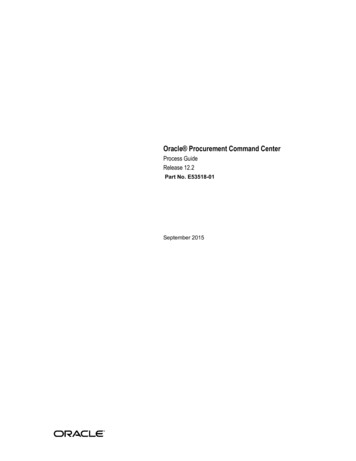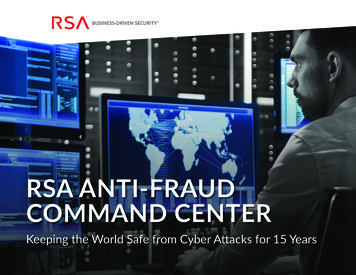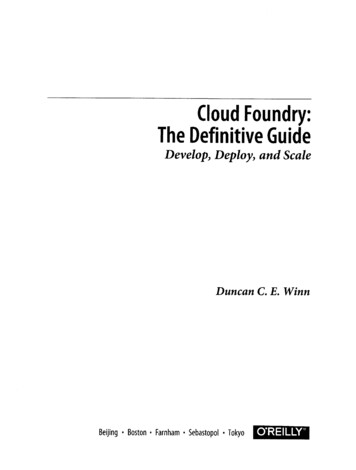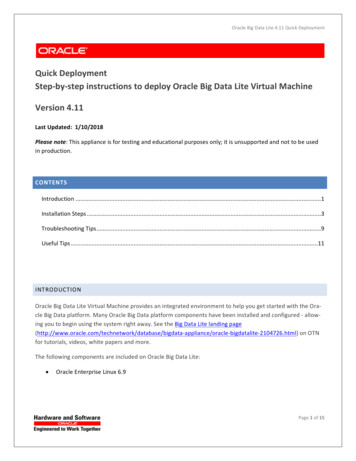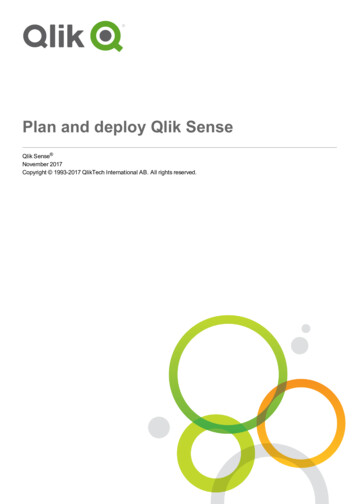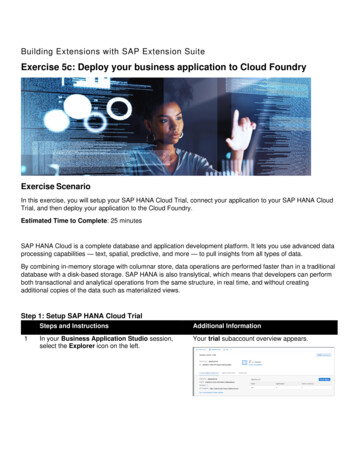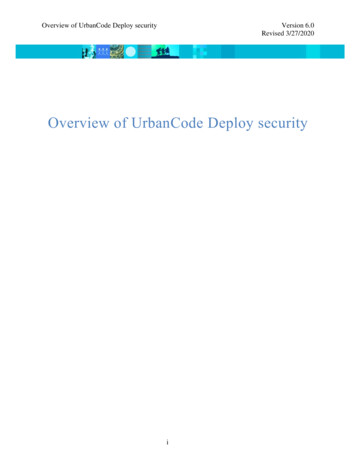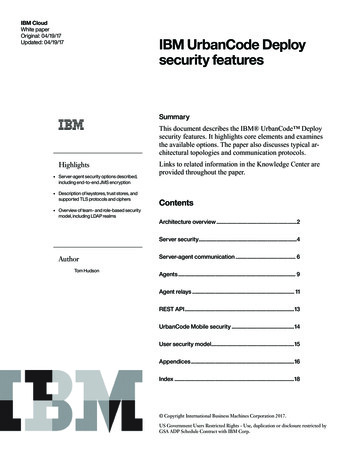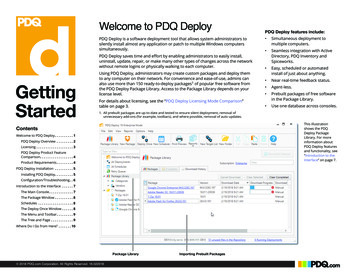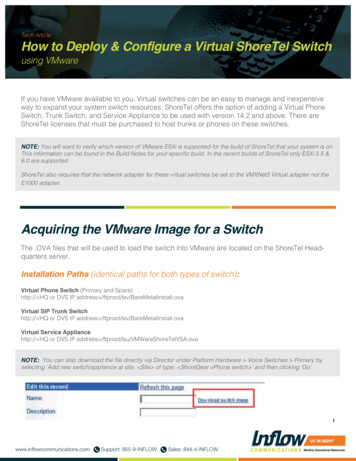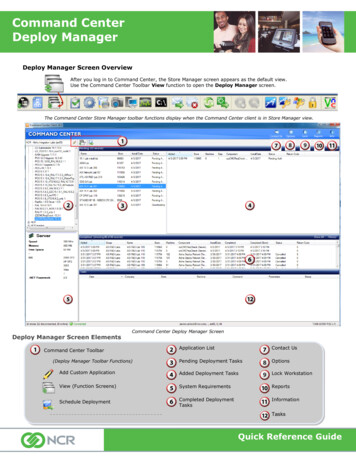
Transcription
Command CenterDeploy ManagerDeploy Manager Screen OverviewAfter you log in to Command Center, the Store Manager screen appears as the default view.Use the Command Center Toolbar View function to open the Deploy Manager screen.The Command Center Store Manager toolbar functions display when the Command Center client is in Store Manager view.Deploy Manager Screen ElementsCommand Center Deploy Manager ScreenApplication ListContact UsPending Deployment TasksOptionsAdd Custom ApplicationAdded Deployment TasksLock WorkstationView (Function Screens)System RequirementsReportsSchedule DeploymentCompleted DeploymentTasksInformationCommand Center Toolbar(Deploy Manager Toolbar Functions)TasksQuick Reference Guide
Deploy Manager Quick Reference GuideDeploy Manager Screen Element DescriptionsCommand Center Toolbar — Provides fast access to key deployment screen tasks, such as adding a custom application, navigatingbetween File Manager, Screen Manager, and Deploy Manager, and scheduling a deployment rollout for a selected application.Application List — Lists the applications available for deployment to one or more sites (up to 1000). Select an application, thenclick the Deploy button to launch the Deploy Application wizard.You can also right-click an application and select Deploy to launch the Deploy Application wizard.The Custom section contains user-defined applications or files that are uploaded to deploy to one or more sites. You can alsoright-click a custom application in the list to launch the Add Custom Deployment dialog box.Pending Deployment Tasks — Lists each incomplete deployment task with one task per line item per site.Double-click a pending task to highlight the corresponding site where the task will deploy.See page 6 for a list of all possible task statuses.Added Deployment Tasks — Displays each component you must install at a site before a pending deployment task is complete.System Requirements — Displays the system requirements to install the selected application on the file server or terminal. If acomputer at a site does not meet the minimum hardware/OS requirements, you cannot include the machine in the deployment.Command Center installs certain pre-requisite applications, such as .NET or SQL, if they are not already installed.CMC does not check prerequisites for custom applications.Completed Deployment Tasks — Displays each deployment task that completed successfully in the last seven days. Forced Doneand Cancelled tasks also appear in this section. To hide a completed task, right-click the task and select Hide Status. Click ShowAll to redisplay hidden tasks. You can also double-click the store number/unit ID for a completed task to access the Store Managerscreen for the selected store.Run the Deploy History Report (Reports Deploy History) to view a list of completed deployment tasks.Contact Us — Enables you to report issues to the Command Center Support team. When reporting an issue, specify which store isaffected and provide contact information, as well as a brief explanation of the issue. You can also contact support from theCommand Center Login screen, or email support at: support@alohaenterprise.com.Options — Enables you to define preferences for unit ID, POS ID or key number display options, alert display options, and more.Lock Workstation — Locks the Command Center client, which will also happen after 10 minutes of inactivity. You must use yourCommand Center password/two-factor authentication to regain access.Reports — Generates informational reports for a company or site. View important details, such as audit trail information, and hardware serial numbers. When you are viewing a report, use the Find button to quickly locate serial numbers. Add comments to any report using the Annotations button, and then print the report along with the comments. Export reports to PDF, Excel, .csv or .txt format, for your business needs.You can generate reports to show user access information at site and company levels.You can also generate reports that display the amount of disk drive space available for computers by site.Information — Provides links to helpful information, such as the license agreement, release notes, Aloha Quick Service andTable Service online help, Command Center Quick Reference Guides, and relevant Web sites.Links to ITSM and Radiant Update are available from the Information icon.Tasks — Displays a list of queries and functions performed. The task status indicates if the task is pending or complete. You can sorttasks by column and right-click to cancel a pending task.When uploading Custom Deploy packages, the upload status will show in the Tasks display.2
Deploy Manager Quick Reference GuideAbout Deploy ManagerExamples of application-specific arguments include:‘/S’ for silent installation or ‘/U’ for unattended installationDeploy Manager is the Command Center remote systemmaintenance screen. Deploy Manager enables you to schedule andrun site POS installations, upgrades, pre-/post-installationapplications, and executable files.7.Optional: Select Reboot, if the system needs to reboot afterinstallation.8.Click OK.To hide NCR-defined deploy groups:To add a custom application from an external URL/Website:1.Right-click on a deployment group.1.2.Select Hide Deploy Group.Click Add Custom. The Add Custom Deployment dialog boxappears.You can make a hidden deploy group visible in the Options menu.Performing Custom Application DeploymentTasksYou can deploy NCR-defined applications and custom (userdefined) applications using Deploy Manager; however, uploadcustom applications before deploying.To upload a custom application:1.Click Add custom. The Add Custom Deployment dialog boxappears.Enter static URL for deploypackage in “Filename” field.Enter name of linked file in“Save As” field.Hover your cursor overany of the empty fieldsfor “Tool Tip”instructions on eachoption.Add Custom Deployment Dialog Box2.Select an application type.3.Optional: Select File transfer only, if you are transferring a fileto one or more stores, but installation tasks are not needed. 4.Type the application name.5.Type the application version number.It is acceptable to use period separators in the version number.Add Custom Deployment Dialog Box2.Select an application type.3.Optional: Select File transfer only, if you are transferring afile to one or more stores, but installation tasks are not needed. 6.Type the application name.5.Type the application version number.It is acceptable to use period separators in the version number.6.Perform one of the following: If you select Server as the application type in Step 2, typethe file URL in the Filename field and any desiredapplication-specific Arguments in the Server group box.Type the name of the file being downloaded in the Save Asbox. If you select Terminal as the application type in Step 2,type the file URL in the Filename field and any desiredapplication-specific Arguments in the Terminal group box.Type the name of the file being downloaded in the Save Asbox. If you select Server Terminal as the application type inStep 2, type the file URL the filename directory paths andany desired application-specific arguments in both theserver and terminal group boxes.Type the path where you would like the file placed afterdeployment in the Transfer To field.4.Perform one of the following: If you select Server as the application type in Step 2,browse for the filename directory path and any desiredapplication-specific arguments in the Server group box. If you select Terminal as the application type in Step 2,browse for the filename directory path and any desiredapplication-specific arguments in the Terminal group box. If you select Server Terminal as the application type inStep 2, browse for the filename directory paths and anydesired application-specific arguments in both the serverand terminal group boxes.Type the path where you would like the file placed afterdeployment in the Transfer To field.Examples of application-specific arguments include:‘/S’ for silent installation or ‘/U’ for unattended installation37.Optional: Select Reboot, if the system needs to reboot afterinstallation.8.Click OK.
Deploy Manager Quick Reference GuideAdd Custom Deploy DetailsWhen uploading a Custom Deployment, hovering the cursor overany available field will provide a Tool Tip explanation outlining thepurpose of that field. These explanations are defined below.Custom Deploy Upload Fields:1.Type - Select “BOH” to deploy to the Server/Gateway only,select “FOH” to deploy to the terminals only, select “BOH FOH”to deploy to all machines.2.Name - Type in the name of the deployment. Make the namedescriptive so you can easily locate it on the list of availablecustom deployments.3.Version - Type in the version of the deployment. This numberwill allow you to differentiate between deployment uploads withthe same name.4.File Transfer Only - Select if the deployment will only betransferred to a machine and will not be executed once thetransfer is complete.5.Continue on Error - When Type is “FOH” or “BOH FOH”,checking this box will continue the deployment to the nextmachine in line if the deployment fails on a machine. If thisoption is not selected, the deployment will stop on the failedmachine.6.Run Server Last - If selected, terminals will deploy first, theserver machine will deploy last. Normal operation has serverfirst, terminals last in ascending order.7.Notes - Add desired notes to describe the custom deploymentpackage. These notes will be visible by any user that views theuploaded deployment.8.Server/Terminal - Server indicates that the options relate tothe “BOH” portion of the deployment. Terminal indicates thatthe options relate to the “FOH” (terminals) portion of thedeployment.9.Filename - Browse for a local file, or specify a fully-qualifiedURL (http, https, and ftp are supported). The site must be ableto download directly from the external URL or the deploymentwill fail.Hover your cursor overany of the empty fieldsfor “Tool Tip”instructions on eachoption.10. Save As - Required for external URL files. Specify the file namefor the file to download and execute at the site (file name only,not path with directory names).11. Arguments - Optional: Command line arguments to beincluded for execution at the site (not applicable for “FileTransfer Only” deployments).12. Transfer To - When “File Transfer Only” is checked, copies thedownloaded file to the directory specified. Requires store-sideCMCAgent v12.2 or later; local drive paths only, UNC paths notallowed.13. Exit Codes - Optional: Specify a comma-delimited list ofinteger exit codes indicating successful installation. If nothing isspecified, “0” is included by default, but if any values arespecified, you must also include “0” if it is an acceptable returncode.14. CRC32 - Optional: Enter a CRC code (in hexadecimal) for thespecified deploy file. For local files, this is calculatedautomatically. This value is used to validate the integrity of thedownloaded file at the site and can be used to preventre-downloading the file on subsequent executions of this deployapplication.15. Reboot - Check this box to perform a machine reboot after thedeployment is complete. The Reboot checkbox under Serverapplies to the BOH/Server deployment, the Reboot checkboxunder Terminal applies to any other machine at the site.4
Deploy Manager Quick Reference GuideThis list contains the samesite and group names thatappear in the site treewhen Command Center isin Store Manager view.To view custom application deploymentconfiguration settings:Right-click the custom application in theApplication List.The read-only View Custom Deployment dialogbox appears.To remove a custom application:1.Select the custom application in theApplication List.2.Click Add/Remove Custom.3.Click Remove.4.Click OK.5.Click Confirm.When selected for“BOH FOH” or “FOH” deployment type, deploymentprocess will continue, ifprevious machine fails.Enter a specific time(36-hour clock - seeAppendix D) ordeployment will defaultto 27:45Remove permanently deletes the customapplication andcancels any associated pending tasks.Scheduling DeploymentsIt is necessary to create a deploymentschedule before assigning it to adeployment task. Once a deployment scheduleis created, you can reuse the schedule for otherdeployments. You can create multipledeployment schedules, as needed.To create a deployment schedule:Use the Find/ Search featureto locate a store by sitename, key number, or unitID. ‘All’ is a valid searchoption.1.Select an application from the Application List.2.Click Deploy. The Deploy Application dialog box appears.3.Click Add. The Schedule dialog box appears.4.Type a descriptive name for the schedule.5.Select the day(s) of the week on which you allow installationsto occur.6.Select the maximum number of sites per day that can receivedeployed applications.Deploy Application Dialog Box2.Click Deploy. The Deploy Application dialog box appears.3.Select the site or site group, listed in the site tree, to includein the deployment.If you select a site group, the system automatically selects allsites associated with the group. If you do not want to installat one of the automatically selected sites, clear the check boxfor that site.4.In the Deployment group box, review the deploymentapplication and version for accuracy.You cannot change the application and version in this dialogbox. Click Cancel to select a different application orapplication version from the Application List.5.Select the start date for the deployment.A warning message appears, if the installation start date isbefore the current date.6.Select a schedule from the drop-down list.If no schedules appear, click Add to create a schedule.7.In the Pre-Install group box, perform one of the following: Select Run pre-install application, if you need to installa prerequisite application before installing the mainapplication (Server only). Continue to step 8.— OR — Schedule Dialog Box7.Click OK.8.Start EOD is selected by default. EOD time is configured incommandcenter.config and defaults to 27:45 (03:45 following thescheduled day).Click Browse to locate and select the desired pre-installapplication.By default, the system installs a pre-install application on thestart date.To schedule an application install or upgrade:1.Leave the check box blank, if you do not require a preinstall application. Skip to step 9.9.Select the application in the Application List.5Optional: Select Reboot, if the system needsto restart after completing the pre-install.
Deploy Manager Quick Reference Guide10. Perform one of the following:Scheduling Deployments (continued) In the Post-Install group box, select Run post-installapplication, if an application must be installed after themain application is installed (Server only). Continue tostep 11.— OR — list of machines included in the scheduled deployment, alongwith installation start dates, and any pre-installation and postinstallation tasks.Leave the check box blank, if you do not require a postinstall application. Skip to step 13.By default, the system installs a post-install application on thesame day of the main installation.Deploy Application Preview11. Click Browse to locate and select the desired post-installapplication.17. Click Finish. The deployment appears as a Pendingdeployment task in the Deploy Manager screen until it isauthorized for deployment.12. Optional: Select Reboot, if the system needs to restart aftercompleting the post-install.To approve a pending deployment task:13. Click Next. The Deploy Application Prerequisite Check scanseach machine included in the deployment for system hardwareand application pre-requisites. The results appear in thePrerequisite Check screen.You must authorize a pending deployment task before thedeployment task can begin.14. If you want to run the prerequisites immediately beforeinstallation, select ‘Run pre-install same day as install.’15. Review the results in the Prerequisite Check screen thenperform one of the following: If there are no failed items, continue to the next step.1.Access the Deploy Manager screen. All pending deploymenttasks appear in the Pending section at the top of the screen.2.Right-click a deployment task.3.Select Approve, to run the deployment at the scheduled time.Several activities occur after you approve a deployment: The status for the selected deployment task changes toQueued until the deployment start date arrives. The installation files are uploaded from the sourcemachine to the file server as early as midnight of thescheduled installation day If you schedule and approve adeployment for the current day,the installation files are uploadedto the file server within a fewminutes of approval.— OR —— OR —When selected, the prerequisites run on the same dayas the application installs.Select Run Now, to run thedeployment activities immediately.You will be asked to confirm your choice and then select YesSTATUS DESCRIPTIONPending Task is waiting approval.AuthorizationWhen selected, the prerequisite check fails for entiresite if at least one machinedoes not met meet therequirements.Queued Task is in line as a scheduled installation at a site.Downloading Task has started to download files, as scheduled.Downloaded Task completed the download file processsuccessfully.The Deploy Application Prerequisite Check Screen displays the list ofmachines included in a deployment under two possible categories: Installing Task is in the process of installing/upgrading theapplication on the computer.Done Task successfully completed the process ofinstalling/upgrading the application. The taskmoves to the Completed section of the DeployManager screen.If one or more failed items appear, click Cancel.Correct the failures before restarting the deployment.Important! Aloha Update does not install POS prerequisites inadvance; therefore, you must include the POS prerequisites as pre-install applications, if you are performing an Aloha Updatedeployment.Download The download file process was unsuccessful.FailedInstall Failed The installation process was unsuccessful.16. Click Next. The Deploy Application Preview screen displays a6
Deploy Manager Quick Reference GuideScheduling Deployments (continued)To cancel a scheduled deployment task:1.Access the Deploy Manager screen.2.Right-click a pending deployment task.3.Select Cancel.4.Click OK.5.Confirm your selection. The deployment task is removedfrom the Deploy Manager screen.To manually update the status of a completed deploymenttask:If a deployment task does not automatically install as scheduled,you can perform a manual installation instead. However, the statusof manually completed deployment tasks are not automaticallyupdated in the Deploy Manager screen. You must manually updatethe status as ’Done.’1.Access the Deploy Manager screen.2.Right-click a pending deployment task.3.Select Force Done.4.Click OK.5.Confirm your selection. The completed deployment task appears in the Completed section of the Deploy Manager screen.To select multiple deployment tasks, press and hold Shift, and left-click to select each deployment task. After selecting each deployment task, right-click to select your next desired action (i.e. Approve, Cancel, or Reschedule).To reschedule a deployment task:1.Access the Deploy Manager screen.2.Right-click a pending deployment task.3.Select Reschedule. The Reschedule Install dialog box appears.Reschedule Install Dialog Box4.Select a new Prereq date for the pre-installation tasks,if necessary.5.Select a new Install date for the main installation tasks,if necessary.6.Click OK.Rescheduled pending deployments do NOT require reauthorization.7
Deploy Manager Quick Reference GuideAppendix A: About Deployment FilesAppendix D: Understanding DeploymentSchedules and InstallationsLocating log files:As discussed in Scheduling Deployments (on page 5), it isnecessary to define a deployment schedule before you canschedule a deployment. A deployment s
Information —Provides links to helpful information, such as the license agreement, release notes, Aloha Quick Service and Table Service online help, Command Center Quick Reference Guides, and relevant Web sites. Links to ITSM and Radiant Update are available from the Information
